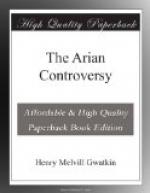and Macarius of AElia (we know that city better as
Jerusalem) were on Alexander’s side, the bishops
of Tyre and Laodicea with the learned Eusebius of
Caesarea leaned the other way or took a middle course.
Altogether there were about a dozen more or less decided
Arianizers thinly scattered over the country from the
slopes of Taurus to the Jordan valley. Of the
Pontic bishops we need notice only Marcellus of Ancyra
and the confessor Paul of Neocaesarea. Arianism
had no friends in Pontus to our knowledge, and Marcellus
was the busiest of its enemies. Among the Asiatics,
however, there was a small but influential group of
Arianizers, disciples of Lucian like Arius himself.
Chief of these was Eusebius of Nicomedia, who was rather
a court politician than a student like his namesake
of Caesarea, and might be expected to influence the
Emperor as much as any one. With him went the
bishops of Ephesus and Nicaea itself, and Maris of
Chalcedon. The Greeks of Europe were few and
unimportant, but on the outskirts of the Empire we
find some names of great interest. James of Nisibis
represented the old Syrian churches which spoke the
Lord’s own native language. Restaces the
Armenian could remind the bishops that Armenia was
in Christ before Rome, and had fought the persecutors
in their cause. Theophilus the Goth might tell
them the modest beginnings of Teutonic Christianity
among his countrymen of the Crimean undercliff.
John the Persian, who came from one or another of
the many distant regions which bore the name of India,
may dimly remind ourselves of the great Nestorian missions
which one day were to make the Christian name a power
in Northern China. Little as Eusebius of Caesarea
liked some issues of the council, he is full of genuine
enthusiasm over his majestic roll of churches far and
near, from the extremity of Europe to the farthest
ends of Asia. Not without the Holy Spirit’s
guidance did that august assembly meet. Nor was
its meeting a day of hope for the churches only, but
also for the weary Empire. In that great crisis
the deep despair of ages was forgotten. It might
be that the power which had overcome the world could
also cure its ancient sickness. Little as men
could see into the issues of the future, the meaning
of the present was beyond mistake. The new world
faced the old, and all was ready for the league which
joined the names of Rome and Christendom, and made
the sway of Christ and Caesar one.
[Footnote 5: 318; in Greek [Greek: tie].]
[Sidenote: The idea of a test creed.]
It seems to have been understood that the council was to settle the question by drawing up a creed as a test for bishops. Here was a twofold novelty. In the first place, Christendom as a whole had as yet no written creed at all. The so-called Apostles’ Creed may be older than 340, but then it first appears, and only as a personal confession of the heretic Marcellus. Every church taught its catechumens the historic outlines




